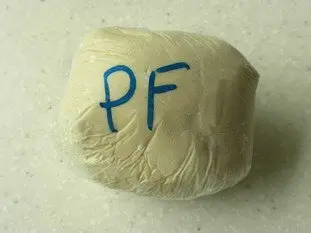What is it?
Behind this odd name hides one of bakery's great secrets: if you want to add flavour to bread dough (not made with leaven, but with yeast), you need to add a little fermented or “soured” dough, that is, dough that was made the previous day.This is exactly the same dough, but it has spent the night in the fridge.
The added soured dough only affects the flavour of the bread: without it, the bread would be quite acceptable, but with it, there is a noticeable improvement. As only the flavour is affected by this optional addition, the bread's appearance and texture remain unchanged.
How do I make it?
The idea might seem confusing, but it is really quite simple: the first time that you make a recipe requiring soured dough, you won't add any (obviously, you won't have any yet).But once you have kneaded this first batch of dough, put 100g aside and keep it in the fridge, covered with stretch plastic film.
The next day, the soured dough will be ready to use. Now you can add it when you make the original recipe again.
Of course, making the same recipe two days running is normally a thing only professional bakers do. For amateurs like us, it is likely to be much later, but this is not a problem: you can just freeze the bit of soured dough, then bring it out to thaw the night before you want to bake the next batch using the recipe.
It is a good idea to make up small packages of 100g, several if possible, so that you have some in stock and can take them out of the freezer as you need them.

What can I use it in?
As I have already mentioned, in any recipe that does not use leaven, certain breads or special breads, such as ciabatta, aperitif rolls, etc. , but also in pizza dough and – more surprisingly, but very effectively – in sweet breads or "viennoiseries".Please note that to keep things simple you can use the same soured dough, let's call it "soured bread dough", for all breads, but for viennoiseries you will need a “soured viennoiserie dough” , made using the recipe for brioche dough, or milk rolls, but leaving out the butter.
To sum up
- Using soured dough really improves the flavour
- It is normal to add around 20% of the weight of flour being used
- A different dough is used for bread and viennoiseries
- It freezes very well






The 2 comments already posted on this page
To make soured dough for Roscoff bread is the classical way: make the dough, without onions and sausage, as usual (step 7 in the recipe https://cooking-ez.com/four/recipe-roscoff-loaf.php, but without soured dough of course), and only the half or quarter of the amount of ingredient. Put this dough in the fridge for the night. The day after, cut in piece of 100g, keep one for the recipe, and put the others in the freezer. Make the Roscoff bread recipe using those 100g. Enjoy it!
I would like to make soured dough for Roscoff bread. Can you write the recipe for soured dough with amounts?
Mersi beaucoup!